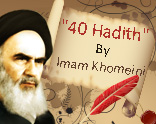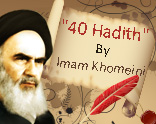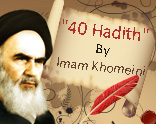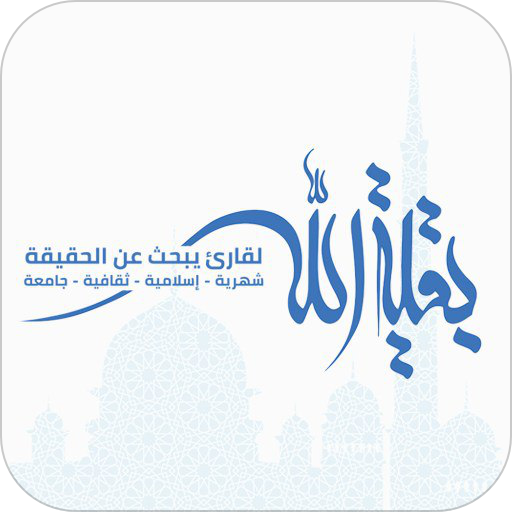With my chain of authorities reaching up to the august shaykh, the Pillar of
Islam, Muhammad ibn Ya`qub al-Kulayni, may God's pleasure be with him, from a
group of our Companions, from Ahmad ibn Muhammad ibn Khalid, from his father,
from Abd Allah ibn Bahr, from Abu Ayyub al-Khazzaz, from Muhammad ibn Muslim,
who said, "I asked Abu Ja'far, may peace be upon him, concerning that which is
narrated, that God created Adam, may peace be upon him, in His form (surah
literally, form, image). He replied, 'It is a form that was originated and
created. He elected it and chose it over all the other different forms and
attributed it to Himself, in the same way that He has attributed the Ka'bah and
the Spirit (ruh) to Himself, saying, "My House" (2:125, 22:26) and "I
breathed into Him of My Spirit" (15:29, 38:72) ' "1
Exposition:
The tradition mentioned in the first part of this noble tradition was one which
has been well-known all along since the times of the Imams, may peace be upon
them, to our own times, and its has been continually cited in the books of the
Shi'ah and the Ahl al-Sunnah. Hadrat Baqir, may peace be upon him, has confirmed
the authenticity of its origin while explaining its meaning. However, there is a
tradition reported by Shaykh Saduq in 'Uyun akhbar al-Rida with his chain of
authorities from the Eighth of the Imams, may peace be upon them, whose meaning
is as follows:
Hussein ibn Khalid says: "I said to Hadrat Rida (A.S.), 'O Son of the Messenger
of God, the people narrate that the Messenger of God, may God bless him and his
Household, said, "God created Adam in His own image." ' The Imam said,
'God damn them! They have omitted the first part of the tradition. The Messenger
of God (pbuh&hh) passed by two men who were abusing each other. The Prophet
heard one of them say to his companion, "May God disfigure your face and of
everyone who looks like you!" Thereat the Messenger of God, may God bless
him and his Household, said, "O servant of God! Don't say that to your
brother, for God, Almighty and Glorious, created Adam in his (His) image."'2
On this basis, marhum Majlisi has ascribed the tradition of Imam Baqir, may
peace be upon him, to taqiyyah (dissemblance), and he has also suggested the
probability that this statement of the Imam might be based on the presumption of
acceptance [of the authenticity or the apparent import of the tradition]3
Such a probability is very remote. That which is probable is that the tradition
of Hadrat Rida (A.S.) refers to the first tradition, where the meaning of "Adam"
in the last part of the tradition where it states:
Verily, God created Adam in His image,
may be that of the human species and the pronoun in على صورته refers to God, the
Exalted. And Hadrat Rida, may peace be upon him, considering that the narrator
was incapable of understanding the meaning of the hadith, related the opening
part of the tradition so that that person may imagine that 'Adam'- means the
father of the human race, with the pronoun in على صورته referring to that man;
so take note.
And perhaps both the traditions are genuine in their origin and import, and the
Messenger of God, may God bless him and his Household, might have stated the
noble tradition without any previous background-and that is the tradition whose
explanation is given by Hadrat Baqir, may peace be upon him-and, on another
occasion, he might have made the statement with that background and Imam Rida,
may peace be upon him, diverted the discussion to the other hadith with a
background due to the incapacity of the narrator in understanding its meaning.
An evidence that supports this suggestion is that in some traditions there occur
the word: على صورة الرحمن (in the image of the All-beneficent)4
instead of على صورته and This is not consistent with the tradition of the `Uyun.
Moreover, even if it be assumed that this noble tradition is not authentic (in
its import), its meaning is implicit in the noble traditions, as will be
explained, God willing. Now we shall turn to explaining the meanings of the
words of the noble tradition.
As to the word Adam,' the Sihah states, "Originally it is with two hamzah's, for
it pertains to the form af'al, and the second hamzah has been altered into an
alif, and when it is to be given a vowel sound it is changed into waw, whereat
its plural is awadim." The reason that Adam, the father of the human race (abu
al-bashar) wag given this name is perhaps because he was had a brown complexion
(asmar al-lawn), as according to the lexicons al-adama min al-nas means someone
who is brownish (al-asmar). And according to some traditions Adam was named so
because he came from the adim of the earth5 adim being in the sense
of `face' and adim-e ard means the surface of the earth.
As to the expression Ala Suratih, Surah in the lexicon is in the sense of
picture and form, and it may be said that it has a general meaning common to
different notions in which the commonality consists of the thingness of a thing
and its actuality (fi'liyyat). However, everything has an actuality in respect
of which it is said to possess a form (dhu al-Surah) and that actuality is
called form (Surah). The application of the term `form' in the terminology of
the philosophers to matters that are inclusive of a thing's actuality and
thingness is not contrary to its lexical meaning, and is not a technical or
special term. Shaykh Abu 'Ali Sina, the chief of the Islamic philosophers, in
the part on metaphysics of his book al-Shifa', says: "At times Surah is applied
to any configuration and act that is in a single or composite recipient so that
its movements and accidents are called surah. Surah (form) is also applied to
something by virtue of which matter is sustained in actuality; hence the
intellectual substances (jawahir Aqliyyah) and accidents cannot be called suwar
(forms). And surah is applied to something by means of which matter becomes
perfect, though it should not be sustained by it in actuality, such as health
and that towards which a thing moves by its own nature (tab'). Also surah is
applied to the species (naw'), genus, and differentia of a thing, or to all of
them. And the universality of the universal in the particulars is also surah."
Reflection on all the instances of the usage of surah shows that in all of them
the criterion is actuality and it is used univocally in all the cases of its
use, to the extent that even God, the Exalted, is called surat al-suwar (the
actuality of all actualities).
As to the word istafaha, safwah means something pure and purged from impurity (kudurat)
and istifa' has the sense of taking that which is clear and pure (safi) and is
implied in its meaning. However, Jawhari and others have considered it to mean
ikhtiyar (choosing), and so they have also considered ikhtiyar to mean isitifa'
in the lexicons. This is, however, an explanation in terms of that which is
implied, as ikhtiyar also means taking that which is good (khayr) and
meritorious, and in this respect coincides with istifa' in external reality,
though it is not synonymous with it.
As to the word al-Ka'bah, it is the name of the House of the God. Some have said
that it has been called Ka'bah due to its resemblance to a cube (muka'ab) or due
to its square shape,5 and muka'ab in the terminology of
mathematicians is a body with six equal planes perpendicular to one another.
As to the word al-ruh, in the terminology of men of traditional medicine ruh
(spirit) is described as "a subtle vapour formed in an animal's heart due to the
heat of the blood." They state that "the heart has two sides. One of them is on
the right, wherein blood is drawn from the lever and there it releases a vapour
due to the heart's heat: Those vapours flow through the left side of the heart
becoming refined there due to the actions of the heart, and from it the animal
spirit is constituted." Then it flows through the blood vessels due to the
expansion and contraction of the heart, in the manner mentioned in the related
works. Thus the source of this animal spirit is the heart and its channels are
the blood vessels. At times the term spirit (ruh) is applied to the blood
centered in the lever, and its channels are the jugular veins, and that is
called the 'natural spirit' (ruh-e tabi'i). So also, in the terminology of the
philosophers 'spirit' is often applied to the psychic spirit (ruh-e nafsani),
which originates in the brain and its channel are the nerves, and that is a
manifestation and lower form of the immaterial spirit pertaining to [the realm
of Divine] command (amr), which is a Divine mystery (sir-e subhani) and the
'spirit of God' (ruhullah), referred to in His words:
﴾And I breathed into him (i.e. Adam) of My spirit. (15:29, 38:72)﴿
Hereafter, God willing, we will explain that this spirit is the one breathed by
the Divine breath and that it is that which is the chosen and elect (mustafa wa
mukhtar) of the Real, Glorious and Exalted.
Section: Explanation that Adam is the Complete Manifestation of God and the
Greatest Name of God, Glorious and Exalted:
It should be known that the people of gnosis (ma'rifah) and the companions of
the heart say that for each of the Divine Names there is a Form (farah) at the
plane of wahidiyyah, which is subject to the tajalli (revelation) pertaining to
the Most Sacred Effusion (al-fayd al-aqdas) at the plane of Divine knowledge (hadrat-e
'ilmiyyah), by virtue of the Divine Self-love and seeking the Keys of the
Hidden, which no one knows except Him. 7 And that Form is called the
preexisting essence ('ayn-e thabit) in the terminology of the People of God (ahl
Allah). And with this tajalli, by virtue of the Most Sacred Effusion are
realized, first, the ta'ayyunat (determinations) of the Names, and, by virtue of
this very ta'yyun of the Names are realized the Forms of the Names, which are
the essences (a'yan-e thabitah). The first Name manifested with the tajaili of
ahadiyyah and the Most Sacred Effusion at the epistemic plane of wahidiyyah (hadrat-e
'ilmiyyah-ye wahidiyyah) and which becomes the mirror of that tajalli, is the
Greatest All-inclusive Divine Name (ism-e a'zam-e jami'-e ilahi) and the station
of the named of 'Allah,' which, from the aspect of the Hidden, is the very
tajalli through the Most Sacred Effusion, and in the tajalli of manifestation of
perfect clarity and luminosity is the same as the all-inclusive station of
wahidiyyah from one viewpoint, and the plurality of Names from another
viewpoint. The ta'ayyun of the all-inclusive Name and its Form consists of the
essence of the Perfect Man and the Muhammadan Reality (haqiqat-e Muhammadiyyah),
may God bless him and his Household. Hence the Sacred Effusion is the
manifestation of the objectifying tajalli of the Most Sacred Effusion, and the
station of Divinity is the manifestation of the tajalli of the station of
wahidiyyah, and the Greatest Spirit (ruh-e azam) is the manifestation of the
tajalli of the ideal essence of the Perfect Man, and all other existents
pertaining to the Names, Knowledge and objective reality are the universal and
particular manifestations of these realities and subtleties, in accordance with
an exquisite explanation that cannot be contained in this brief discourse and
whose details we have mentioned in the treatise Misbah al-hidayah.8
From here it is known that the Perfect Man is the manifestation of the
all-inclusive Name and the mirror of tajalli of the Greatest Name, and to this
matter these are many references in the Qur'an and Sunnah. God, Exalted, has
said:
﴾And He taught Adam the Names, all of them. (2:31)﴿
This Divine instruction took place in respect to the inmost being of Adam
through his Hidden, all-inclusive fashioning with the Hands of Beauty and
Majesty (jamal wa jalal) at the plane of wahidiyyah. Similarly, the fashioning
of his form and appearance in the visible world ('alam-e shahadat) took place
through the manifestation of the Hands of Majesty and Beauty in the mirror of
physical nature (tabi'at). And God, the Exalted, has said:
﴾Verily, We presented Our trust to the heavens and the earth.
(33:72)﴿
and the 'Trust' (amanah) in the creed of the Gnostics is the absolute wilayah,
of which no being except man is worthy. This absolute wilayah is the same as the
station of Sacred Effusion to which reference is made in the Noble Scripture in
His statement:
﴾Every thing is fated to perish save His Face. (28:11)﴿
And in a tradition of the noble al-Kafi, Imam Muhammad Baqir, may peace be upon
him, is cited as having said:
We are the Face of God.9
And it is mentioned is the Du'a-e nudbah:
Where is the Face of God towards which the friends of God turn?
Where is the link that connects the Earth's people with the Heaven?10
And in the Ziyarat-e jami'ah they are referred to as the, (the highest
similitude, or metaphor)." This similitude and the attribute of being the Face
is the same as the image (surah) mentioned in this Noble tradition:
Indeed, God created Adam in His image.11
That is, Adam is the highest similitude (al-mathal al-a'la) of God, His greatest
sign, and the most complete manifestation and mirror of the tajalliyat of the
Names and the Attributes, the Face of God (wajh Allah), the Eye of God ('ayn
Allah), the Hand of God (yad Allah) and the side or proximity of God (janb
Allah).
He hears, sees, and holds by God, and God sees, hears and holds by him. 12
This wajh Allah is the same `Light' mentioned in the noble verse:
﴾God is the Light of the heavens and the earth! (24:36),﴿
And Imam Baqir, may peace be upon him, said to Abu Khalid Kabuli in a tradition
of the noble Kafi:
They (i.e. the Imams) are, by God, the Light that He has sent down (64:8; 61:8;
39:69), and they, by God, are the Light of God in the heavens and the earth
(24:36).13
And the noble Kafi-narrates a tradition of Imam Baqir, may my soul be sacrificed
for the dust of his feet, that while expounding the noble verse:
﴾Of what do they question? Of the great tiding? (78:1-2)﴿
he said,
It refers to the Commander of the Faithful (Ali). And the Commander of the
Faithful, may peace be upon him, used to say: "There isn't a greater sign of
God than me, and there isn't a greater tiding of God than me!14
Hence, the Perfect Man, one of whose instances is Adam, the father of Men, is
the greatest sign, manifestation, Name and Attribute of the Real, and he is the
metaphor and sign of God, the Exalted. God, the Blessed and the Exalted, is
above having a like (mithl) and a peer, but one should not negate the existence
of a metaphor for His sacred Essence, as
﴾And to Him belongs the highest metaphor (mathal). (30:27)
All the particles of the realm of being are the signs and mirrors of the
revelations (tajalliyat) of the Beauty of the Beautiful One, Almighty and
Exalted, though each one of them is such only to the extent of it existential
capacity. But none of them is the sign of the greatest all-inclusive Name, that
is, Allah,' except the all-inclusive being (kawn-e jami') and the sacred station
of the greatest mediation (maqam-e muqaddas-e barzakhiyyat-e kubra), glorious is
his greatness with the Greatness of his Maker
Hence, God, the Exalted, created the Perfect Man and the First Man in His
all-inclusive Image, and He made him the mirror of His Names and Attributes. The
Great Shaykh (Muhyi al-Din Ibn 'Arabi) has said: "Hence all that which was in
the Divine Form of the Names was manifested in this human existent, and so it
acquired the station of all-inclusiveness (al-ihatah wa al-jam') with this
existence and with it was established God's argument against the angels:'
From this discussion is known the reason for God's choosing and electing the
all-inclusive human form from among the various forms of other entities, and the
secret of God's giving precedence to Adam, may peace be upon him, over the
angels and His giving him a dignity over all other existents and His attributing
his spirit to Himself, in the Noble verse:
﴾And I breathed into Him of My spirit. (15:29)﴿
As our intent in these pages is observance of brevity, we shall refrain from
explaining the reality of the Divine breath and its character in Adam, and His
singling him out for it from among all the existents. And all Praise belongs to
God, firstly and lastly.
* Book: Forty Hadith (An Exposition on 40 ahadith narrated through the
Prophet (pbuhh&hh) and his Ahl al-Bayt (a.s.)). By Imam Ruhullah al-Musawi al-Khumayni.
Translated by: Mahliqa Qara'i (late) and Ali Quli Qara'i.
1- Al-Kulayni, Usul
al-Kafi i, 134 "kitab al-tawhid," "bab al-ruh," hadith 4.
2- Al-Shaykh al-Saduq, 'Uyun akhbar al-Rida, i, 119, bab 11, hadith 12. The text
of the tradition is as follows:
3- Al-Majlisi, Mirat al-'uqul, ii, 84, "kitab al-tawhid," bab al-ruh, hadith 4.
4- Sadr al-Muta'allihin, Tafsir al-Qur'an al-Karim, ii, 235; Ibn 'Arabi, Futuhat
al-Makkiyyah, ed.'Uthman Yahya, i, 78.
5- Al-Shaykh al-Saduq, 'Ilal al-sharayi', i, 26. The text of the tradition is as
follows:
6- Al-Tabrisi, Majma' al-bayan, exegesis of 5:97; Qamus al-lughah, under k-'-b,
Ka'bah.
7- A reference to verse 6:59.,
8- Imam Khumayni, Misbah al-hidayah ila al-khilafah wa al-wilayah, pp. 28-42,
54-56.
9- Usul al-Kafi, i, 145, "kitab al-tawhid," bab al-nawadir, hadith 7.
10- Zad al-ma'ad, bab 11, p. 399; Mafatih al-janan, 537.
11- Al-Shaykh al-Saduq, Man la yahduruh al-faqih, ii, 370, "bab al-ziyarat al-jami'ah;"
'Uyun akhbar al Rida, bab 68, hadith 1.
12- Usul al-Kafi, "kitab al-iman wa al-kufr," "bab man adha al-muslimin," hadith
7.
13- Ibid., i, 194, "kitab al-hujjah," "bab anna al-a'immah nur Allah," hadith 1.
14- Ibid., i, 207, "kitab al-hujjah," "bab anna al-ayat al-lati dhakaraha Allahu
fi kitabih . . .," hadith 3




















